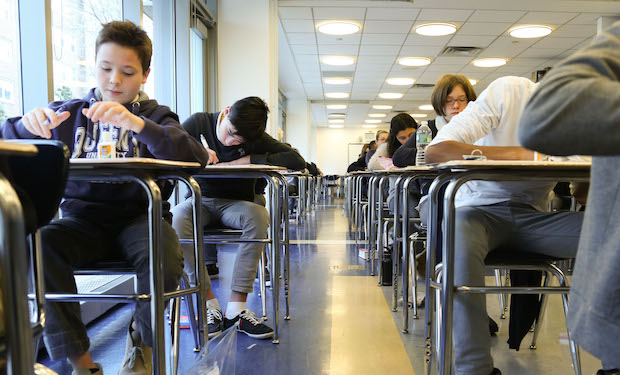At back to school 2016, student schedules in middle school and high school will undergo a major reform, with the creation of block scheduling. Each day will have fewer classes of longer duration, and many classes will extend to a double period to allow more time for in-depth study and collaborative work. School days will no longer extend late in the day, limiting classes after 4pm.
LFNY: Where does the idea of block classes come from?
Nicolas L’Hotellier (NLH): It started four years ago with our discussions on student well-being and the rhythm of the school day. We were focused on how to better organize time and space for our students. With the construction of the new York Wing, we’ll have additional classroom space, which will make it possible to implement the schedule.
Why increase classes from 45 to 55 minutes?
NLH: Until 2009, Secondary classes were 55 minutes long, following the standard of the French educational system. But, when we added dialogue hours for individual teaching support to students, we had to reduce class time to make up for that lost class period. We have always envisioned revisiting that decision. But, it was imperative that we keep dialogue hours in place, as they have been such a tremendous improvement for our students.
Starting in September 2016, all class periods in secondary will be organized in blocks of 55 minutes. Our own research shows that it takes about 8 minutes for students to get settled and ready to learn in a class, and that the last few minutes of class are spent collecting their things for the next class. That doesn’t leave enough time for focused teaching of students. We knew had to find a better solution.
Why teach in blocks?
NLH: If you look at a typical schedule today, each student has up to eight different teachers in a single school day. This “Taylorist” view of scheduling was no longer in line with our vision for teaching at the Lycée Français. To really support our students in the acquisition of knowledge and understanding, they have to have more time in each subject — time for project-based learning, for group work, for research, for experimentation, and time for teachers to individualize their approach to the different levels in a class. This is difficult in 45 minutes, and still difficult in 55 minutes. We will be implementing teaching in blocks, with a course length of 110 minutes, or 2 class periods.
110 minutes of class. Isn’t that long?
NLH: Students and teachers will benefit from this new approach. Longer class periods will reduce time that’s wasted when students transition from one class to another. More important though, because teachers will have fewer classes to prepare each day, they will be able to spend more time going into depth in each class with their students. When one thinks of 110 minutes in a standard lecture hall, I would agree that’s too long. In the new block schedule, time in the extended class sessions will alternate between group and individual work, lecture time and also testing time. The format and organization of each class is at the discretion of the teachers, which will give them more freedom to organize classes as they would like and to innovate in their teaching.
There is a tremendous benefit to our students in studying in one extended period rather than having shorter classes a few times a week. With shorter and more frequent class periods, students have to stop and start more often in each subject, and, in essence, start over again with each class and with shorter class periods, they don’t have time to go into deeply into concepts. Of course, some adaptations are planned, for example, in the case of world languages classes (langues vivantes), where frequent encounters with the material are better.
Is the new schedule compatible with our accreditations?
NLH: Absolutely! The different tracks and baccalaureate formats, as well as all the electives we offer at the Lycée Français de New York, make us unique. We should note that the important place of our extra-curricular activities, and challenging scheduling time for them for all students can be. But, we believe we have found a solution in this structure of teaching, which will respect not only our academic program of the French Ministry of National Education, but also allow our students to leave class earlier so that they can make time for extra-curricular activities, whether sports, arts, music, technology or whatever area they choose to explore. With this new schedule, we are able to use the autonomy that we are given by the French Ministry of Education to meet the unique needs of our own students.

